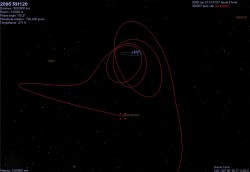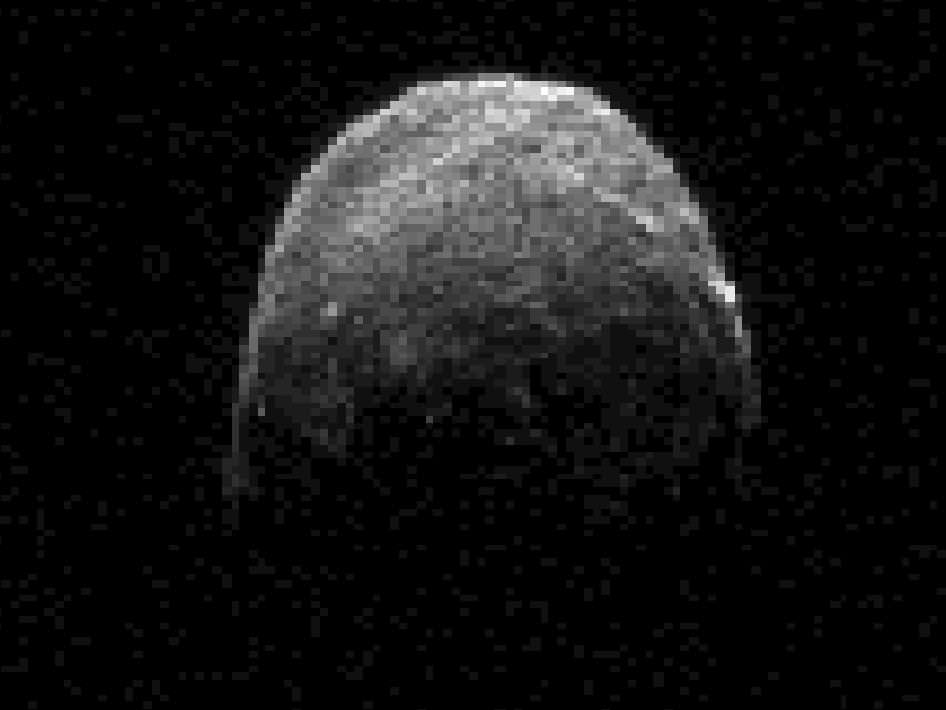[/caption]
Look up in a clear night sky. How many moons do you see? Chances are, you’re only going to count to one. Admittedly, if you count any higher and you’re not alone, you may get some funny looks cast in your direction. But even though you may not be able to actually see them, there may very well be more moons out there orbiting our planet.
For the time being, anyway.
Today, Earth has one major moon in orbit around it. (Technically the Earth-Moon system orbits around a common center of gravity, called the barycenter, but that’s splitting hairs for the purpose of this story.) At one time Earth may have had two large moons until the smaller eventually collided into the larger, creating the rugged lump we now call the farside highlands. But, that was 4 billion years ago and again not what’s being referred to here.
Right now, at his moment, Earth may very well have more than the one moon we see in the night sky. Surprise.
Of course, it would be a very small moon. Perhaps no more than a meter across. But a moon nonetheless. And there could even be others – many others – much smaller than that. Little bits of solar system leftovers, orbiting our planet even farther out than the Moon we all know and love, coming and going in short-lived flings with Earth without anyone even knowing.
This is what has been suggested by researcher Mikael Granvik of the University of Helsinki in Finland. He and his colleagues have created computer simulations of asteroids believed to be occupying the inner solar system, and what the chances are that any number of them could be captured into Earth orbit at any given time.

The team’s results, posted Dec. 20 in the science journal Icarus, claim it’s very likely that small asteroids would be temporarily captured into orbit (becoming TCOs, or temporarily captured objects) on a regular basis, each spending about nine months in up to three revolutions around Earth before heading off again.
Some objects, though, might hang around even longer… in the team’s simulations one TCO remained in orbit for 900 years.
“There are lots of asteroids in the solar system, so chances for the Earth to capture one at any time is, in a sense, not surprising,” said co-author Jeremie Vauballion, an astronomer at the Paris Observatory.
In fact, the team suspects that there’s most likely a TCO out there right now, perhaps a meter or so wide, orbiting between 5 and 10 times the distance between Earth and the Moon. And there could be a thousand smaller ones as well, up to 10 centimeters wide.
So if these moons are indeed out there, why don’t we know about them?
Put simply, they are too small, too far, and too dark.
At that distance an object the size of a writing desk is virtually undetectable with the instruments we have now.. especially if we don’t even know exactly where to look. But in the future the Large Synoptic Survey Telescope (LSST) may, once completed, be able to spot these tiny satellites with its 3200-megapixel camera.
Once spotted, TCOs could become targets of exploration. After all, they are asteroids that have come to us, which would make investigation all the easier – not to mention cheaper – much more so than traveling to and back from the main asteroid belt.
“The price of the mission would actually be pretty small,” Granvik said. And that, of course, makes the chances of such a mission getting approved all the better.
Read more on David Shiga’s article on New Scientist here.


If the IAU’s definition of a planet excludes Pluto then one must wonder what their definition of a ‘moon’ is… or at least will be after they jump all over this. I cannot imagine they would classify a meter wide body as a moon. Dwarf moon perhaps?
The IAU has not ratified any formal definitions for moon. The best anyone can do is consult dictionaries, and there will be disagreement.
By the way, can we all please not have a big whinge about the IAU’s definition of planet, regardless of what side of the fence we all sit on? I will be very disappointed if this comment section turns into another one of those…
By the way, can we all please not have a big whinge about the IAU’s definition of planet, regardless of what side of the fence we all sit on? I will be very disappointed if this comment section turns into another one of those…
squidgeny… My post was a sad attempt at humor. I personally could care less what the IAU calls a planet, moon, etc…
If intelligent life existed on any of the gas giants I am sure their alien version of an IAU would state that the Earth, Mars, Venus and Mercury did not meet the definition of a planet. They would be too rocky, small, and not enough atmosphere
I know I know, I just wanted to nip it in the bud
I do think it would be a fun exercise to discuss how we might define moon though… there would presumably have to be a few classes, depending on the properties of its parent object, and the nature of its orbit…
If we tried to define the term moon–which is probably not a good idea–there would have to be multiple classes. How could Earth’s Moon be in the same class as Mars’ two moons, which are essentially captured asteroids? We would also have to distinguish between moons captured by their parent planets versus those that formed with their planets or via giant impact. For example, Triton, having been captured by Neptune, is in an unstable orbit, and will eventually crash into Neptune. While we are talking about very long time scales, such factors would be important when considering which moons, if any, could host even primitive forms of life. Big moons of gas giants in exoplanet systems could end up being places where we find life.
The definition of a moon.
Thanks !!!
Deimos, Phobos and many extreme elliptical equatorial impacts argues that they are in the same class as our Moon, reformed impact ejecta. As the Mars sized impactor on Earth created the Moon, a Moon sized impactor on Mars probably created them and the Borealis north/south dichotomy at the same time.
Only they weren’t large enough to aggregate into one body. Of those moons, only Deimos will remain indefinitely.
Why, in this scenario, would Deimos and Phobos not have aggregated into one larger moon?
The first few minor planets were considered to be planets when they were discovered. It was only after it was realised there were going to be dozens, if not hundreds of them that they were reclassified.
Indeed. How many ‘moons’ do Jupiter and Saturn have if rocks only a meter in size are counted?
Yeah, calling it simply moon is blown out of proportions. Oops, shrinked in of proportions. :d
All planet-moon systems orbit around a barycenter. I’m not sure why that has to be pointed out as if it is unique
I’m sure Jason knows this, it’s just some ambiguous writing. Maybe we can casually say the Moon orbits around the Earth because the barycentre is within Earth’s volume – whereas it might, for example, be wrong to say Charon orbits Pluto, since the barycentre lies outside of Pluto’s volume.
That would be tricky to get into because then you could say it might be wrong to call Jupiter a planet of the Sun since it’s barycenter lies outside of the Sun’s volume.
If I didn’t explicitly state it, I’m sure someone would have eagerly pointed it out. So I was being preemptive.
If we start to count transient moons, we would have to add all the artificial space junk that swamps the natural background.
I, for one, welcome our stable moon-ing Overlord!
What about dusts and gas particles in orbit around earth? are they also in technical sense a satellite?
Hmm… that last “whip” that thing did, what could have caused it? Another object perhaps?
Keep in mind that the graphic shows motion in the reference frame of a stationary Earth. So the “whip” may not be as dramatic as it appears when viewed in a “Sun-stationary” reference frame. My guess is that it’s nothing more than the object’s faster motion near perihelion.
If we can identify a reasonable size TCO it would be a great way to practice asteroid landing, capture and control as well as resource extraction. We need to be prepaired to find and deflect potential impact asteroids as an impact is inevitable eventually. In addition with limited resources on earth and falling cost of space travel it is only a matter of time that space based resource extraction becomes ecconomic.
Finding these TCO’s would be a good start to incremental improvement to our space based capabilities.
If they are as small as the likeliest parking offender above, ~ 1 m, I would not recommend landing as much as capture. =D
But it is a very good idea! The graphic shows a body way closer than the usual NEO object. And the scientific return may be greater (more potential diversity).